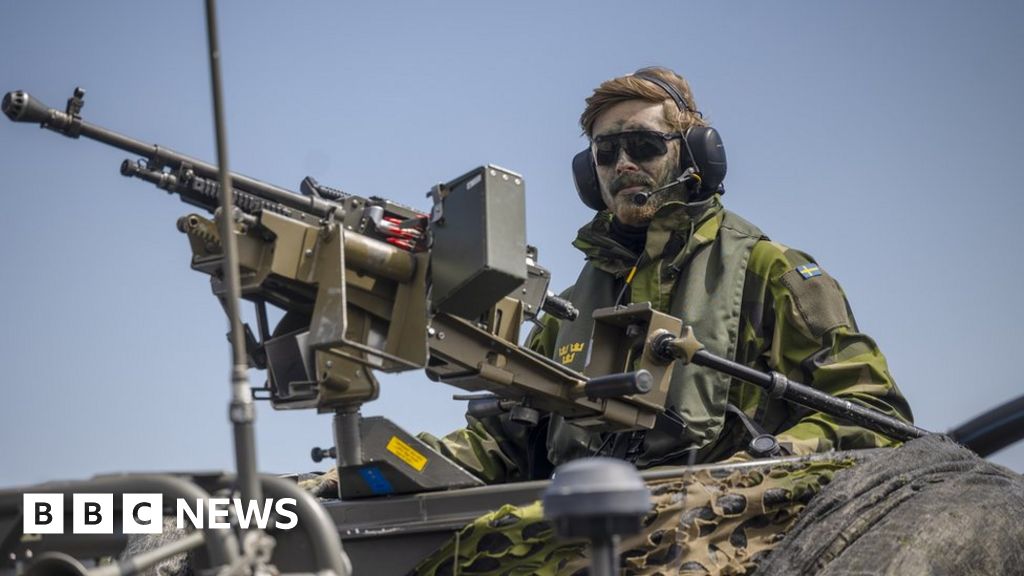Image source, Getty Images
Sir Keir Starmer is attending the Nato summit in Washington DC – his first international trip since becoming prime minister.
In a speech to mark the 75th anniversary of the military alliance on Tuesday, US President Joe Biden said Nato was “more powerful than ever” and that it faced a “pivotal moment”, with the war between Russia and Ukraine.
What is Nato and why was it set up?
Nato – the North Atlantic Treaty Organization – was formed in 1949 by 12 countries, including the US, UK, Canada and France.
Its founding treaty was signed in Washington DC, and leaders of Nato countries marked the anniversary on the first day of the summit, which is taking place between 9 – 11 July.
Image source, Getty Images
Image caption, Nato was founded in Washington DC in April 1949
Nato’s primary purpose was to block expansion in Europe by the Soviet Union – a group of communist republics which included Russia.
Nato does not have an army of its own, but member countries can take collective military action in response to crises.
Which countries are Nato members?
Nato has 32 members across Europe and North America, including the UK, US, Canada, France, Germany, Italy, Spain and Turkey.
After the Soviet Union’s collapse in 1991, many Eastern European countries joined: Albania, Bulgaria, Hungary, Poland, the Czech Republic, Slovakia, Romania, Lithuania, Latvia and Estonia.
Finland – which has a 1,340km (832 mile) land border with Russia – joined in April 2023. Sweden became a member in March 2024.
Both had applied to join in May 2022, shortly after Russia invaded Ukraine, having been neutral for decades.
Ukraine, Bosnia and Herzegovina, and Georgia also hope to join Nato.
Why is Ukraine not in Nato, and when could it join?
Russia has consistently opposed the idea of Ukraine joining Nato, fearing it would bring the alliance’s forces too close to its borders.
After Russia’s invasion, Ukraine’s President Zelensky asked for his country to be admitted as soon as possible.
Outdoing Nato secretary-general Mr Stoltenberg previously said it was “inevitable” that Ukraine would become a member, but not until its war with Russia ends.
Image source, Getty Images
Image caption, Outgoing Nato boss Jens Stoltenberg told President Volodymyr Zelensky that Ukraine can join in “the long-term”
Since July 2023, the US-led Ukraine Defense Contact Group has been coordinating efforts to give Ukraine weapons and training to defend itself against Russia.
Nato is proposing to take over that role by creating a $100bn fund to support Ukraine over the next five years.
How are Nato countries helping Ukraine?
Nato has not sent troops to Ukraine or enforced a no-fly zone over the country, for fear of being pulled into a direct conflict with Russia.
However, individual members have supplied arms to help Ukraine defend itself.
The German research organisation the Kiel Institute says the US has allocated 50.4bn euros (£42.6bn) for military support to Ukraine, while European countries – Denmark, Germany, the Netherlands, Poland and the UK – have allocated 32bn euros (£27bn).
The US, UK, Germany and Turkey and others have provided anti-tank weapons, missile defence systems, artillery guns, tanks and military drones. The US, UK and France have also supplied long-range missiles.
Image source, Getty Images
Image caption, Nato countries are supplying Patriot air defence systems to Ukraine
President Zelensky has spent months pleading with his Western allies for more weapons.
How is Nato increasing its defences against Russia?
In 2023, Nato commanders agreed detailed plans for countering possible Russian attacks anywhere in the Arctic and north Atlantic, central Europe, or the Mediterranean region.
How much do Nato members spend on defence?
Nato asks every member country to spend at least 2% of its national income on defence, and 23 of them are projected to meet that target in 2024. Only three did in 2014.
The biggest spenders (in proportion to the size of their economies) are the US and countries close to Russia, such as Poland and the Baltic Republics.
Former Conservative Prime Minister Rishi Sunak committed the UK to increasing its military budget to 2.5% of national income from the current 2.3%.
When he was US President, Donald Trump pushed European Nato members to boost their defence spending.
At a campaign rally on Tuesday, Mr Trump told supporters that Nato countries were now contributing “hundreds of billions of dollars” more because he had warned them: “No, I will not protect you from Russia” unless they paid more to the alliance.
Source link : https://www.bbc.com/news/world-europe-18023383.amp
Author :
Publish date : 2024-07-10 08:59:51
Copyright for syndicated content belongs to the linked Source.
